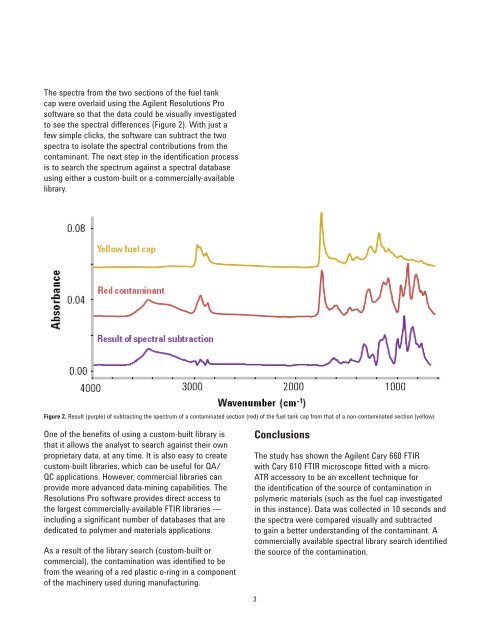Application Compendium - Agilent Technologies
Application Compendium - Agilent Technologies
Application Compendium - Agilent Technologies
You also want an ePaper? Increase the reach of your titles
YUMPU automatically turns print PDFs into web optimized ePapers that Google loves.
The spectra from the two sections of the fuel tank<br />
cap were overlaid using the <strong>Agilent</strong> Resolutions Pro<br />
software so that the data could be visually investigated<br />
to see the spectral differences (Figure 2). With just a<br />
few simple clicks, the software can subtract the two<br />
spectra to isolate the spectral contributions from the<br />
contaminant. The next step in the identifi cation process<br />
is to search the spectrum against a spectral database<br />
using either a custom-built or a commercially-available<br />
library.<br />
Figure 2. Result (purple) of subtracting the spectrum of a contaminated section (red) of the fuel tank cap from that of a non-contaminated section (yellow)<br />
One of the benefi ts of using a custom-built library is<br />
that it allows the analyst to search against their own<br />
proprietary data, at any time. It is also easy to create<br />
custom-built libraries, which can be useful for QA/<br />
QC applications. However, commercial libraries can<br />
provide more advanced data-mining capabilities. The<br />
Resolutions Pro software provides direct access to<br />
the largest commercially-available FTIR libraries —<br />
including a signifi cant number of databases that are<br />
dedicated to polymer and materials applications.<br />
As a result of the library search (custom-built or<br />
commercial), the contamination was identifi ed to be<br />
from the wearing of a red plastic o-ring in a component<br />
of the machinery used during manufacturing.<br />
Conclusions<br />
The study has shown the <strong>Agilent</strong> Cary 660 FTIR<br />
with Cary 610 FTIR microscope fi tted with a micro-<br />
ATR accessory to be an excellent technique for<br />
the identifi cation of the source of contamination in<br />
polymeric materials (such as the fuel cap investigated<br />
in this instance). Data was collected in 10 seconds and<br />
the spectra were compared visually and subtracted<br />
to gain a better understanding of the contaminant. A<br />
commercially available spectral library search identifi ed<br />
the source of the contamination.<br />
3

















